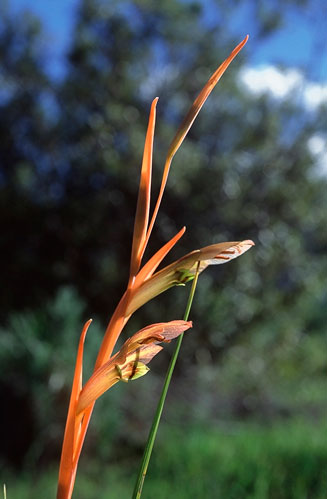|
Gladiolus abbreviatus
Slangkop, Suikermannetjie [Afrikaans] Life
> eukaryotes >
Archaeoplastida >
Chloroplastida
>
Charophyta > Streptophytina > Plantae (land plants)
> Tracheophyta (vascular plants) > Euphyllophyta > Lignophyta (woody plants)
> Spermatophyta (seed plants) > Angiospermae (flowering
plants) > Monocotyledons > Order: Asparagales
> Family: Iridaceae > Genus:
Gladiolus
 |
|
|
Gladiolus abbreviatus flowering in spring
near Villiersdorp, Western Cape, South Africa. [photo
Colin Paterson-Jones ©] |
|
Unless otherwise indicated, information is from
Goldblatt and Manning (1998 pp. 306-307).
Identification
- The very short lower tepals are distinctive.
- This is the only species of Gladiolus in southern Africa with
coloured floral bracts: they can be pale to olive green, flushed with red,
brown or orange.
Distribution and habitat
Endemic to the Western Cape, South Africa, where its
distribution extends from Caledon to Stormsvlei (east of Riviersonderend),
southwards to near Cape Agulhas. Within this region it is found in renosterveld
vegetation usually on moist, south-facing clay and shale banks, especially where
the area has been heavily grazed or cleared.
Life cycle
- A geophyte, with a corm measuring 10-12 mm in diameter.
- Flowers from mid-June to mid-August, sometimes also in September.
- Seeds are ovate, often tapering at one end, broadly winged, measuring
about 6-7 mm long by 4 mm broad.
Ecological interactions
Pollinator
-
Nectarinia famosa (Malachite sunbird). The reddish colouring of the
floral bracts presumably hightens the visibility of the flowers to this
pollinator.
Meaning of name
abbreviatus - means abbreviated in Latin, referring
to the short lower tepals, which are 3-6 mm long compared with the dorsal tepal
which can be up to 30 mm long (Goldblatt and Manning 1998 pp. 306-307).
Publications
- Goldblatt P. and Manning J. 1998. Gladiolus in Southern Africa.
Fernwood Press, Vlaeberg, Cape Town.
Text by Hamish Robertson |
